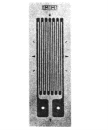Unit - 12
Structural Engineering
Q1) What is structural engineering?
A1) Structural engineering is a sub-discipline of civil engineering of structural engineers who are skilled to design the 'bones and muscles' that create the form and shape of manmade structures.
Structural engineers calculate the stability, strength, and rigidity of built structures for buildings and non-building structures.
The structural designs with other designers such as architects and building services engineer and constantly supervise the construction of projects by contractors on site.
Structural engineering is painstaking a forte discipline within civil engineering, but it studied in its own right.
In the United States, most working structural engineers are currently licensed as civil engineers, but it varies from state to state.
Some states have a separate license for structural engineers which is required to design special structures such as schools, hospitals, or skyscrapers.
In the United Kingdom is recording the structural engineers in the building industry are members of the Institution of Structural Engineers or the Institution of Civil Engineers.
Q2) Explain Tall structures in brief.
A2)
Q3) Explain Experimental Stress Analysis.
A3)

R= 
Where,
L is the length,
A is the cross-sectional area and
ρ is the specific resistance or resistivity
Q4) What are the Various types of bridges?
A4)
Types of Bridges based on Type of Super Structure:
1) Arch bridge
2) Girder bridge
3) Truss bridge
4) Suspension bridge
Types of Bridges based on Materials:
1) Timber bridge
2) Masonry bridge
3) Steel bridge
4) R.C.C bridge
5) Prestressed concrete bridge
Types of Bridges based on Span:
1) Culvert bridge
2) Minor bridge
3) Major bridge
4) Long span bridge
Types of Bridges based on Function:
1) Footbridge
2) Highway bridge
3) Railway bridge
4) Aqueduct bridge
5) Road cum railway bridge
Types of Bridges based on Inter Span Relation:
1) Simple bridge
2) Continuous bridge
3) Cantilever bridge
Types of Bridges based on Position of Floor:
1) Deck bridge
2) Through bridge
3) Semi-through bridge
Types of Bridges based on High Flood Level (HFL):
1) Low-level bridge
2) High-level bridge
Q5) Write Some Types of buildings.
A5) The government various types of buildings based on different criteria depending on their usage, design, and height, safety standards, and other features as follows.
1) Residential Buildings
2) Educational Buildings
3) Institutional Buildings
4) Assembly Buildings
5) Business Buildings
6) Mercantile Buildings
7) Industrial Buildings
8) Storage Buildings
9) Wholesale Establishments
10) Mixed Land Use Buildings
11) Hazardous Buildings
12) Detached Buildings
13) Semi-Detached Buildings
14) Multi-Storey or High-Rise Buildings
15) Slums
16) Unsafe Buildings
17) Special Buildings
Q6) Explain different types of buildings in brief.
A6)
1) Residential Buildings:
2) Educational Buildings:
3) Institutional Buildings:
4) Assembly Buildings:
5) Business Buildings:
6) Mercantile Buildings:
7) Industrial Buildings:
Q7) Explain Water retaining structures.
A7)
Q8) What are the Other structural systems? Explain each.
A8)
1) Trusses:
2) Shear structures:
3) Bending structures:
Q9) What is Wind tunnel? Explain.
A9)